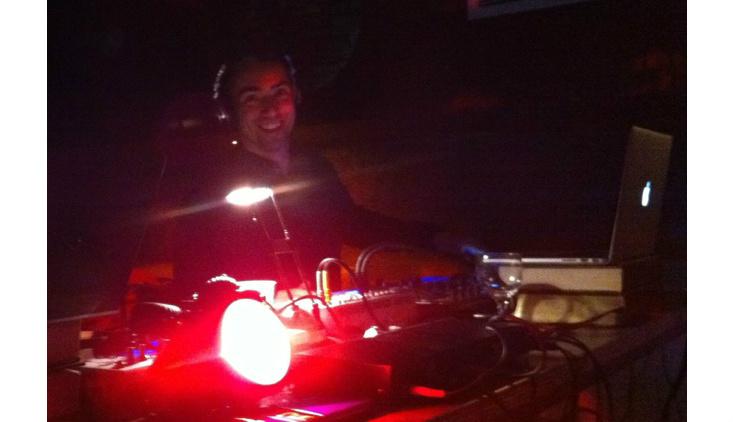DJ Angst kicked off the late-February show at the Root Cellar Lounge in Bloomington, Indiana, keeping in mind that, as the first DJ to play, it was his job to figure out what would lure people to the dance floor. As his name implies, he prefers austere, dark electronic music, but he gathered that the edgy techno he started off with wouldn’t resonate with the assembling crowd.
He and his partner, DJ E-Trash, expected a low-key affair. But the crowd soon sent signs they were angling for a raucous night. As a few women started to shimmy along with the music, DJ Angst kicked up the BPMs (beats per minute) with some UK garage, heavy on vocals urging the crowd, “C’mon now, let’s get hot.” Energy levels started to rise. People were singing and moving along. A pumping electronic baseline sent four couples straight to the dance floor.
For the next hour, he kept it steady at a nice, even 120 BPM. “I don’t want people to peak too early,” says DJ Angst, also known as Johan Bollen, “otherwise they’ll get exhausted and it will kill the night.” When he hands the show off to DJ E-Trash, who goes by “Luis Rocha” during daylight hours, the dance floor is full. “They were really dancing, waiting for that signal to let go.”
E-Trash gave it to them, in the form of remixed disco, funk, and R&B hits. “I pay attention to everything from the baseline and chord progression to the gestures of the crowd,” he says. As soon as he played a new version of Rod Stewart’s “Da ya think I’m sexy?,” the crowd went nuts. “Most DJs know how to rev up an audience, but Luis and Johan know how to also sustain it,” says Root Cellar manager Josh Johnson.
“Our research—the notion of feedback and complex systems—informs everything we do. A DJ and an audience are a cybernetic system, controlling each other’s state.”
It may just seem like people having simple fun at a club, but there’s something deeper going on. “We use the crowd to communicate with each other,” says Bollen. “We’re encoding information in the crowd.” Bollen cites a technical term for this: stigmergy, a form of indirect coordination of actions. The term describes, for example, how ant colonies make effective “decisions” in complicated situations, even though each ant’s behavior is very simple. The ants use pheromones to exchange information; the environment serves as their shared memory. Complexity spontaneously emerges from simplicity.
Bollen and Rocha are experts on stigmergy—for real. They DJ by night, but by day they study cybernetics—how people, animals, and machines control and exchange information—at Indiana University in Bloomington. A focus on feedback runs through their both their research and DJing. And while they really just want to orchestrate a raging party, the crowd is, in a sense, an experiment.

Bollen and Rocha, both Europeans, consider themselves post-national citizens of the world. Rocha, born in Angola, raised in Portugal, and educated in the UK, chose a DJ name that is, playfully, short for “Euro Trash.” Bollen grew up in Belgium, influenced by music, culture, and science coming out of Germany and France.
They first worked together at Los Alamos National Lab, where Rocha served as Bollen’s U.S.-based advisor while Bollen conducted research for his PhD in experimental psychology for the Vrije University in Brussels, Belgium. Their mutual love of computing and behavioral science motivated early efforts to figure out how the Web could produce collective intelligence.
At Los Alamos they realized their dual passions for research and music were eerily similar, rooted in mixing and matching components of different disciplines, as well as musical genres, to create something new—be it novel intellectual territory or a fresh mix of tracks. (Fittingly enough, Manhattan Project scientists Richard Feynman and John von Neumann, also both known partiers, forged new fields of quantum mechanics and game theory, respectively, while at Los Alamos.)
Careers took them in different directions, but Bollen and Rocha remained colleagues, and in 2009 they ended up working in the same department at Indiana University. In recent years they have explored novel ways to analyze collective behavior. For example, they use data from Twitter or Google searches to characterize social behavior and predict financial events, social unrest, and even sexual behavior. “I look at what data are available, such as social media postings, to tease apart emergent patterns of behavior,” says Bollen. Predicting mood is a big focus of their work.
“We love the mechanics and feel of DJing. The science just adds to the awe of what’s going on.”
In 2011, Bollen made headlines when he published evidence that Twitter mood could predict future stock market fluctuations with impressive accuracy. It categorized language from 9.8 million tweets into 6 dimensions: calm, alert, sure, vital, kind, and happy. Bollen showed that calmness of the public mood most accurately predicted Dow Jones Industrial Average fluctuations two to six days later. Calmness is, in one sense, the opposite of fear, which is known to drive market decisions.
Perhaps not surprisingly, their research interests bled into their music, as they started DJing together. Bollen, for example, organizes his songs according to similar mood models he developed for his Twitter research. Songs are categorized along two primary dimensions: energy level (bpm) and “valence”—the feeling of the music, consisting of a spectrum of universal emotions, from dark or edgy (cold) to inviting or velvety (warm). At the February show, for example, Bollen picked up on the crowd’s vibe, ramped up the energy level, and, at 124 bpm, played “The Feeling” by Eden—a warm, inviting song that signaled that the party was truly underway. “Our research—the notion of feedback and complex systems—informs everything we do,” says Bollen. “A DJ and an audience are a cybernetic system, controlling each other’s state.”
While their research interests inform their approach to DJing, they prefer to let a “sophisticated form of intuition” take over once inside the club door. “It can’t be art if you overthink it,” says Bollen. “The pleasure comes from becoming part of the system in real time.” The two DJs help each other stay in that groove: While one has his hands full with the music, the other watches the crowd, and they give each other feedback throughout the night. It’s not uncommon for Rocha to suggest Bollen is going too dark or Bollen to ask Rocha to dial back on the pop.
Bollen has contemplated videotaping and studying their performances. They could monitor the level of dancing or how many new people join the dance floor—details that could, one day, lay the foundation for a robot DJ, he half-heartedly muses. “But that would suck all the fun out of it,” he admits. The whole point is the very human process of co-creation.
“We love the mechanics and feel of DJing,” says Bollen. “The science just adds to the awe of what’s going on.”
Virginia Gewin is a freelance science journalist perched in Portland, Oregon. Follow her on Twitter @VirginiaGewin.






























